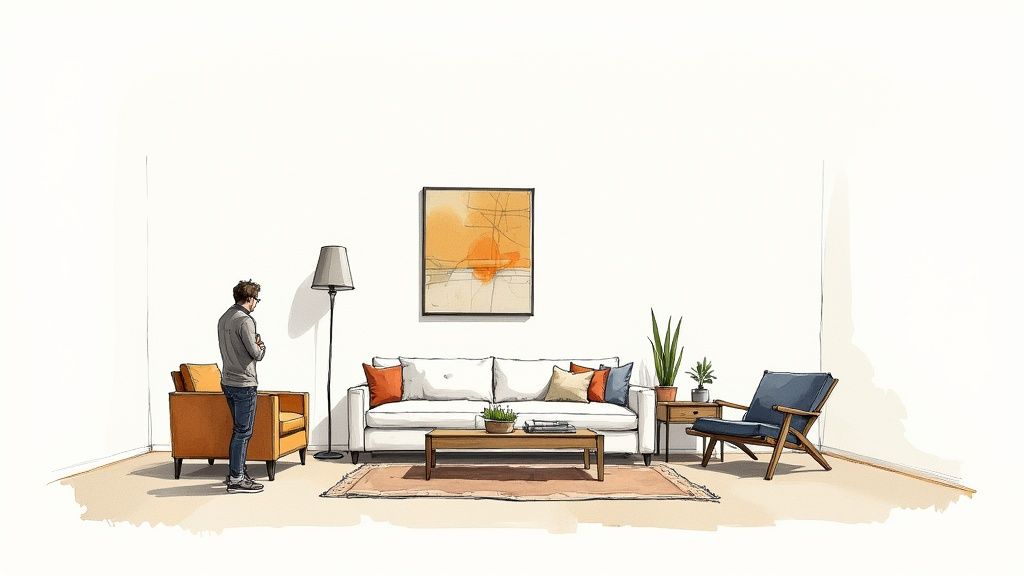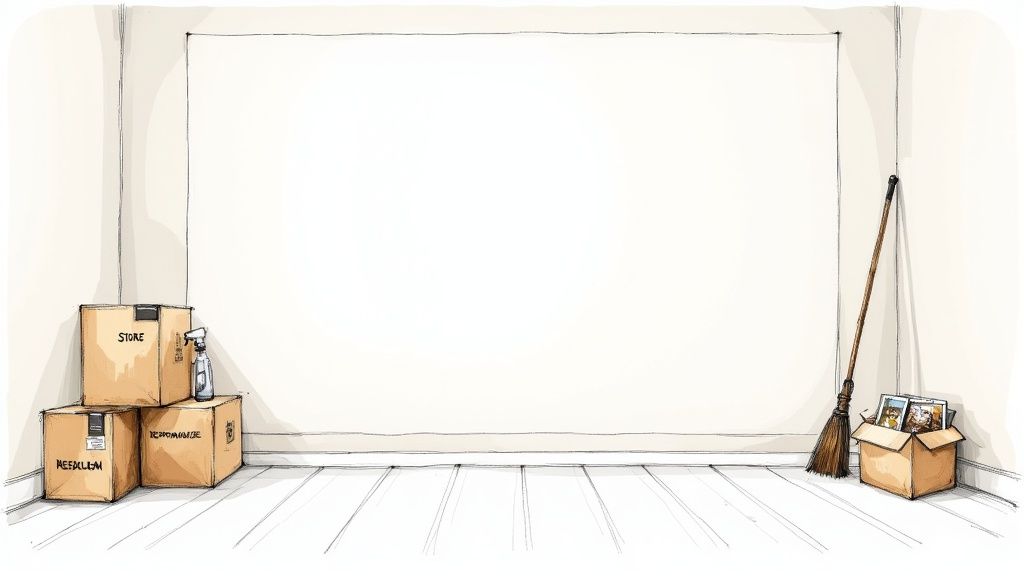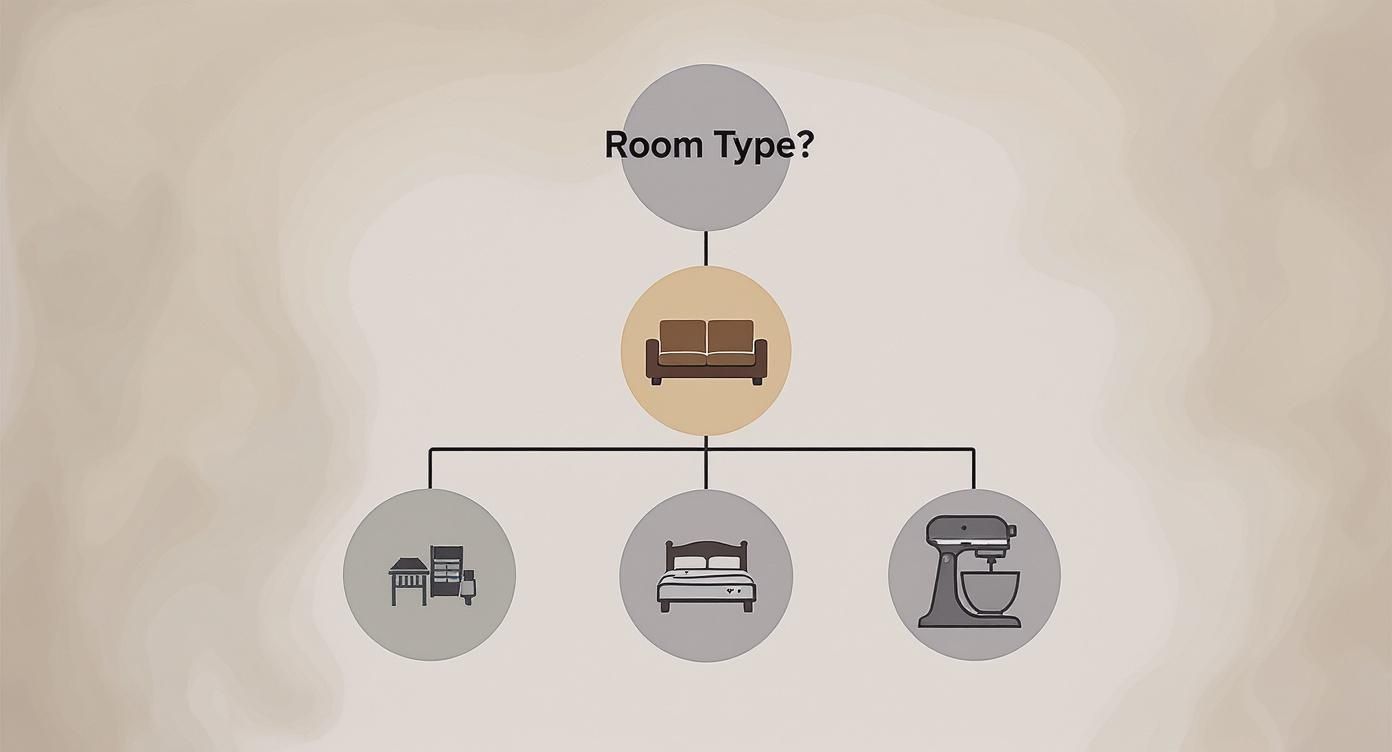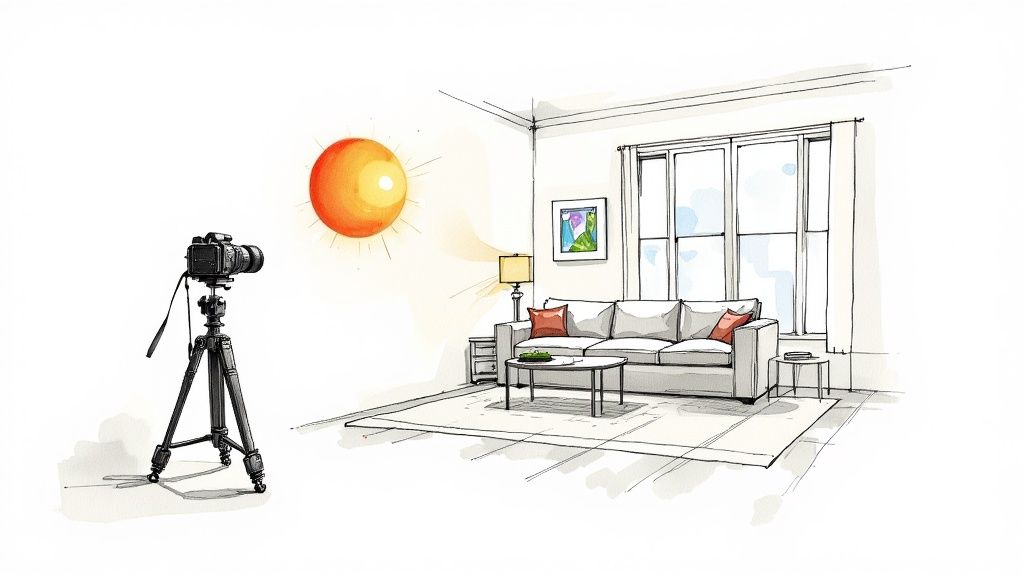Staging Interior Design to Sell Homes Faster
Sell properties faster and for more. Our guide to staging interior design covers proven room-by-room tips, virtual staging, and high-ROI strategies.
Staging isn't just about making a house look pretty. It's a powerful marketing strategy that helps a property sell faster and for more money. Think of it this way: you're not just selling four walls and a roof; you’re selling a future. Staging helps potential buyers see themselves living—and thriving—in that space. It transforms a house into a home they can aspire to.
Why Staging Is Your Secret Weapon in Real Estate

When you're selling a property, you're selling a dream. Buyers are looking for the backdrop to their future memories. That’s why staging interior design is no longer a "nice-to-have"—it's a critical part of the sales playbook. This isn't about decorating to your personal taste; it's about creating a look that speaks to the widest possible audience of buyers.
A thoughtfully staged home accomplishes things an empty or cluttered house just can't.
- It Builds an Emotional Bridge: Staging helps buyers connect with a space. That cozy armchair by the window becomes their future reading spot. A beautifully set dining table makes them imagine hosting holiday dinners.
- It Solves Awkward Spaces: Have a weird nook or a small, undefined room? Staging gives every single area a clear purpose, showing buyers exactly how they can use the space. No more head-scratching.
- It Shows Off the Good Stuff: Great staging draws the eye to a home's best features, like a stunning fireplace or big, bright windows, while minimizing any potential flaws.
- It Backs Up the Price Tag: A professionally staged home simply feels more valuable. It signals that the property is well-cared-for and ready to go, making buyers feel more confident about the asking price.
Physical vs. Virtual Staging: What's the Difference?
You have two main paths to get these results: physical staging or virtual staging. Physical staging is the traditional route, where you bring in real furniture and decor. This gives buyers a tangible, in-person experience they can walk through and touch.
Virtual staging, on the other hand, is all digital. You use specialized software to add stylish furniture and decor to photos of empty rooms. It’s a fantastic, budget-friendly way to show off a property's potential online and grab a buyer's attention right from the start. Honestly, a smart real estate strategy often uses a mix of both.
"Staging is more than just the sterile living room-in-a-box you’ve seen at open houses; it is a tool for bringing aspects of your identity into your space."
Looks Matter More Than Ever
This focus on aesthetics isn't just a fleeting trend. It’s a major shift in what buyers expect. The interior design industry is booming, with some analysts predicting the market could blow past USD 208 billion by 2033.
What's driving this? We're all more visually savvy thanks to social media and design shows. This cultural shift means a professional presentation is non-negotiable. You can dive deeper into the interior design market growth on Renub Research to see just how big this is getting.
Creating the Perfect Canvas Before You Stage
Great staging isn't just about what you put into a room; it’s about what you take out first. Before a single piece of furniture is placed—physically or virtually—you have to prep the space. Think of yourself as an artist. You wouldn't start a masterpiece on a dirty, cluttered, or damaged canvas, right? The same principle applies here.
This prep phase is absolutely non-negotiable if you want your staging to have maximum impact. It’s where the real magic begins.

I’ve found it’s easiest to break this down into what I call the "Three D's" of preparation: Declutter, Deep Clean, and Depersonalize. Let's walk through them.
Declutter with Purpose
This is often the hardest step for homeowners. They’re attached to their stuff, and that's understandable. Your job is to gently guide them, explaining that we're not asking them to get rid of their memories, we're just making room for a buyer’s dreams.
A simple rule of thumb I give clients is the "Pack, Donate, or Trash" system. The goal is to clear out at least 50% of the items from every closet, cabinet, and bookshelf. This creates an immediate feeling of spaciousness and abundant storage.
- What to Pack Away: Family photos, quirky collections, personal trophies, and any niche decor that screams "this is my house."
- What Can Stay: A few neutral art pieces, a couple of elegant coffee table books—anything that adds style without telling a personal story.
When a potential buyer can mentally "move in" without being distracted by the current owner's life, you're halfway to an offer.
The goal isn’t to erase the home's personality entirely, but to neutralize it. A buyer should walk in and think, "I can see myself living here," not, "I wonder who lives here now."
Deep Clean Like You Mean It
A quick wipe-down just won't cut it. We’re talking about a forensic-level deep clean that leaves no corner untouched. Buyers have eagle eyes for dirt and grime, and even a little can subconsciously signal that the property hasn't been well-maintained.
I always tell my team to focus on the spots that get overlooked in a regular clean but are always noticed by discerning buyers:
- Windows and Light Fixtures: Sparkling windows flood a room with natural light, making it feel bigger and more inviting. Dust-free fixtures add a sparkle that suggests meticulous care.
- Baseboards and Crown Molding: Wiping these down creates crisp, clean lines that frame the room beautifully. It's a small detail with a huge impact.
- Kitchen and Bath Grout: You’d be amazed how much brighter a kitchen or bathroom looks with freshly scrubbed grout. It can make old tile look new again.
- Appliance Interiors: Oh, they will open the oven and the fridge. Make sure they are spotless inside and out.
A professionally cleaned home just feels different. It smells fresh and looks pristine, building buyer confidence from the moment they walk through the door.
Depersonalize for Broad Appeal
Depersonalization is the final polish on your blank canvas. This is where you remove anything highly specific to the seller's taste—that bright orange accent wall, the extensive collection of memorabilia, or the kids' artwork taped all over the refrigerator.
This is also the perfect time to tackle those small but nagging repairs. Patching nail holes, fixing a drippy faucet, or replacing burnt-out light bulbs are minor tasks that have a major payoff. They eliminate small objections before a buyer even has a chance to form them.
Honestly, one of the most powerful tools in this phase is a fresh coat of neutral paint. It's the ultimate reset button, making any space feel cleaner, bigger, and more modern almost instantly.
Choosing the right neutral is key. You want something that feels warm and inviting, not sterile. Here are a few of my go-to paint colors that appeal to the widest range of buyers.
High-Impact Neutral Paint Colors for Staging
This table highlights some versatile, buyer-friendly neutral paint colors, breaking down their undertones and where they work best to create maximum appeal.
| Paint Color Name (Example) | Undertone | Best For | Psychological Effect |
|---|---|---|---|
| Benjamin Moore "Revere Pewter" | Warm Gray (Greige) | Living rooms, open-concept spaces, and hallways | Warm, sophisticated, versatile |
| Sherwin-Williams "Agreeable Gray" | Soft Greige | Bedrooms, kitchens, and bathrooms | Calm, inviting, light |
| Behr "Swiss Coffee" | Creamy Off-White | Any room needing warmth without yellow undertones | Cozy, bright, airy |
| Farrow & Ball "Elephant's Breath" | Warm Gray with a hint of magenta | Dining rooms and master bedrooms for a touch of drama | Elegant, serene, modern |
By taking the time to meticulously prepare the canvas, you set the stage for success. Every design element you add later—whether it's a real sofa or a virtually staged one—will look ten times better and have a far greater impact on potential buyers.
A Room-By-Room Playbook for Physical Staging
Alright, the heavy lifting is done. The home is decluttered, scrubbed clean, and has a fresh coat of neutral paint. Now comes the fun part: bringing the space to life. Great staging is all about creating little scenes—vignettes that tell a story. You want every room to whisper to buyers, "This is it. This is the happy, organized life you've been dreaming of."
This isn't just about plunking furniture down. It's a strategic game of placement, layering, and hitting those emotional triggers. Let's walk through the key rooms and I’ll show you exactly how to apply some core staging interior design principles to make them pop.
Crafting a Conversational Living Room
The living room is your first real impression, so you absolutely have to nail it. The goal is to show buyers a space that's perfect for both kicking back and hosting friends. It all comes down to creating a flow that feels intuitive and welcoming.
Start by setting up a clear conversation area. This means positioning a sofa and a couple of armchairs so they face each other, inviting people to talk—not just stare at a blank wall where a TV might go. A huge tip here: pull the furniture away from the walls. It instantly makes the room feel bigger and more intimate.
Next, you need to ground that grouping with an area rug. I can't tell you how many times I've seen a rug that's too small; it just makes the whole room feel choppy and disconnected. Make sure the front legs of your main seating pieces are all comfortably on the rug.
- Layering is Everything: Toss some plush throw pillows and a soft blanket on the sofa. This isn't just for looks; it’s a non-verbal cue that says, "Go on, sit down, get comfortable."
- Vary Your Lighting: A single overhead light is harsh and sterile. Bring in at least two other light sources—think a floor lamp and a table lamp—to create a warm, layered glow.
- The Coffee Table Edit: I live by the "Rule of Three" for coffee tables. Group three items of different heights, like a stack of art books, a small plant, and a cool decorative object. It adds visual interest without looking cluttered.
The living room should feel like a deep, relaxing exhale. Your arrangement needs to communicate comfort and possibility, making buyers feel like they’re already home.
The Kitchen: A Taste of the Good Life
There's a reason they say kitchens sell homes. But a cluttered, messy kitchen can torpedo a deal just as fast. Here, your mission is to showcase a space that's spacious, functional, and spotless, with just enough personality to feel warm. When it comes to countertops, remember this: less is more.
Seriously, clear everything off except for a few well-chosen items. You're trying to suggest a lifestyle, not put every single kitchen gadget on display.
For instance, on one side of the stove, lean a nice wooden cutting board against the backsplash with a small bottle of fancy olive oil. On the other, a simple bowl of fresh lemons or green apples adds a fantastic pop of natural color. These little touches make the kitchen feel alive, like someone is about to whip up a delicious meal.
If you're looking for more specific inspiration, our in-depth guide is packed with kitchen staging ideas to attract buyers that will help you master this critical space.
Designing a Tranquil Master Bedroom
The master bedroom needs to feel like a serene escape—a private sanctuary where the new owners can shut out the world. The absolute, non-negotiable focal point is the bed.
Make that bed the star of the show. Dress it in crisp, neutral linens—you can never go wrong with white, cream, or a light gray. Then, layer it up with pillows (two sleeping pillows, two shams, and a couple of smaller decorative ones) for that luxurious, hotel-vibe. Draping a soft throw across the foot of the bed adds that final touch of texture and comfort.
In the bedroom, symmetry is your secret weapon.
- Matching Nightstands: Flank the bed with identical or at least complementary nightstands.
- Symmetrical Lighting: Top each nightstand with a matching lamp. This creates a sense of balance and calm.
- Centered Artwork: Hang one large, calming piece of art—something abstract or a landscape works well—above the headboard to anchor the whole room.
Get all personal clutter off dressers and nightstands. Buyers don't want to see family photos or medicine bottles. Replace it with something simple, like a decorative box or a single flower in a small vase. And make sure the closets are only about half-full; it gives the powerful illusion of having tons of storage space.
Creating a Spa-Like Bathroom
Even the tiniest bathroom can be turned into a spa-like retreat with a few clever staging tricks. Just like the kitchen, the name of the game is emphasizing cleanliness and creating a feeling of pure relaxation.
Start by clearing the vanity of all personal toiletries. Nobody wants to see a used toothbrush. Get that stuff out of sight. Replace it with a few carefully chosen, aspirational items.
- Luxe Accessories: A simple tray holding a nice soap dispenser, an elegant candle, and a tiny succulent can instantly make the space feel more high-end.
- Plush Linens: Always, always use a fresh set of fluffy, white towels. Fold them perfectly on the towel rack or roll them up and place them in a wicker basket.
- Organic Touches: Bathrooms are full of hard, shiny surfaces. Soften the look by bringing in some natural elements. A small wooden stool next to the tub or a simple plant can make the room feel so much warmer and more inviting.
A sparkling clean shower is a must. Scrub away any soap scum and hang a brand-new, clean shower curtain liner. By focusing on these details in each room, you’re not just showing a house; you're weaving a compelling story that turns a simple walkthrough into an experience a buyer won't forget.
The Smart Alternative: Virtual and AI Staging
So, you’ve prepped the perfect canvas, but what if your budget or timeline makes physical staging a non-starter? Maybe you're dealing with a brand-new build that's completely empty, or a property with decor so dated it's scaring buyers away. This is where virtual and AI-powered staging becomes one of the most valuable tools in your arsenal.
Imagine being able to fully furnish a vacant home, from the sofa to the silverware, without lifting a single box. That’s the magic of this technology. It takes high-quality photos of empty rooms and digitally adds realistic furniture, art, and accessories to show buyers a property’s true potential. You're not just filling space; you're creating an emotional connection before a buyer even sets foot inside.
When Should You Use Virtual Staging?
While it’s a game-changer, virtual staging isn't a one-size-fits-all solution. Knowing when to deploy it is key to getting the biggest bang for your buck. It really shines in specific scenarios where physical staging is just impractical or too expensive.
Consider these prime opportunities:
- Completely Vacant Properties: An empty home feels cold and confusing in photos. Virtual staging is perfect for helping buyers understand the scale of each room and envision their life there.
- Outdated or Occupied Homes: For properties with furniture that doesn’t quite hit the mark for today’s buyers, you can digitally "remove" the old decor and "add" a fresh, contemporary look. It’s a visionary alternative.
- New Construction Listings: Trying to sell a unit from a floor plan and empty photos is tough. Showing buyers what a finished, furnished space will look like is far more compelling.
- Budget-Conscious Projects: This is a big one. Virtual staging can cost up to 97% less than traditional physical staging, making it a powerful and accessible option for almost any listing.
The tech behind these visuals is getting better by the day. Generative AI and 3D visualization tools are transforming how we present spaces, driven by consumer demand for tech-savvy solutions and the industry’s need for faster marketing.
Choosing the Right Design Style
The biggest mistake I see agents make is choosing a design style that completely clashes with the home's architecture. A rustic farmhouse theme just looks bizarre in a sleek, downtown condo. Your goal should be to pick a look that enhances the property's natural character and speaks directly to your target buyer.
Think about who is most likely to buy this home. Young professionals? A growing family? Retirees? Your design choice should reflect their likely tastes.
- For a modern downtown loft, go with a Mid-Century Modern or Industrial style. Think clean lines, natural wood, and cool metal accents.
- For a classic suburban family home, a Transitional or Modern Farmhouse look is almost always a winner. It’s comfortable, inviting, and feels timeless.
- For a high-end coastal property, a Coastal or Scandinavian design works beautifully, emphasizing light, natural textures, and a serene, airy vibe.
This decision tree gives you a simple framework for matching a room with the right staging approach.

Think of it as a cheat sheet to connect a room’s purpose with an aesthetic that makes sense.
Ethics and Best Practices
Virtual staging is a fantastic marketing tool, but transparency is non-negotiable. You have to be upfront with potential buyers that the furnishings are digital. If you don't, you risk creating disappointment and eroding trust when they walk into an empty house.
Always clearly label virtually staged photos in your MLS listing, on your website, and in any marketing materials. A simple disclaimer like "Virtually Staged" is all it takes to maintain your professional integrity.
Beyond disclosure, the quality of the staging itself matters immensely. Poorly executed digital decor can look fake, with shadows that don't make sense or furniture that's scaled all wrong. A bad virtual staging job can do more harm than an empty room.
Look for a provider that:
- Shows a portfolio of realistic, high-quality work.
- Understands proper lighting and perspective.
- Has a vast library of modern furniture and decor.
For a deeper dive into the technology, it's helpful to see how AI video generation software explained works, as many of the same principles apply. If you’re ready to try it yourself, our own guide on how to create virtual home staging offers a step-by-step walkthrough.
When done right, virtual staging bridges the imagination gap. It helps you sell a vision, not just an empty space.
Capturing Your Staged Home with Great Photos

You’ve done all the hard work—the decluttering, the deep cleaning, and nailing the perfect staging interior design. Now comes the final, crucial step: capturing it all in stunning photographs. These days, a buyer’s first showing happens online, not at the front door. Your listing photos are your single most powerful marketing tool, and they absolutely must do justice to the beautiful space you’ve created.
Think about it: mediocre photos of a brilliantly staged home can kill a buyer's interest before they even think about scheduling a visit. You have to approach the photography with the same strategic eye you used for staging, focusing on light, angles, and composition to make every single shot count.
Let There Be Light: Making Your Photos Shine
Light is everything in photography. It's the one thing that can make a room feel bigger, cleaner, and more inviting all on its own. The goal is simple: create a bright, airy atmosphere that feels warm and welcoming from the moment someone sees the picture.
Natural light is your best friend here. If you can, try to schedule your photoshoot for a bright but overcast day; direct, harsh sunlight creates nasty shadows that are hard to work with. The "golden hours"—that soft, beautiful light just after sunrise and before sunset—are also fantastic for getting a flattering glow.
- Flip Every Switch: Even with daylight pouring in, turn on every single lamp and overhead light. This layering of light fills in any lingering shadows and gives the room more depth.
- Open It All Up: Pull back every curtain and open every blind. You want to let in as much natural light as possible to make the space feel open and connected to the outdoors.
- Ditch the On-Camera Flash: Please, avoid using the flash built into your camera. It creates a flat, harsh look that makes everything feel cold. Pros use external flashes bounced off ceilings to create soft, even light that looks completely natural.
Your main objective is to make every room look its absolute brightest and most cheerful. A well-lit photo sends a powerful message: this is a positive, happy home. That's exactly the feeling you want to spark in potential buyers.
Finding the Perfect Angle and Composition
How you frame a shot can completely change the perception of a space. The right angle makes a room feel expansive and shows off its best features, while the wrong one can make it seem cramped and awkward.
A great place to start is from the corner of a room, aiming your camera toward the opposite corner. This classic technique captures the most square footage and creates a real sense of depth. Always try to shoot from about chest height—going too low or too high can distort the room’s proportions and just feel… off.
Getting the perfect shot is an art, and our detailed guide has even more pro-level insights. Check out these other https://pedra.ai/blog/real-estate-photography-tips to really make your images stand out.
The growing demand for beautiful homes is undeniable. The global interior design market was valued at USD 137.9 billion in 2024 and is on track to hit USD 175.7 billion by 2030, with North America leading the way. This isn't just a fleeting trend; it’s proof that buyers are willing to pay for aesthetics. Investing in high-quality visual presentation is simply meeting that massive consumer demand.
Your Go-To Shot List for a Complete Listing
Don't just wander through the house snapping pictures. You need a plan. A shot list keeps you organized and ensures you capture every angle and detail needed for a listing that tells a complete story.
Here's a sample shot list to get you started:
- Wide-Angle Room Shots: Get at least two different angles of every key room—living room, kitchen, primary bedroom, etc.
- Detail and Vignette Shots: Zoom in on the small things that add character. A beautifully arranged coffee table, a cozy reading nook, or stylish kitchen hardware can tell a "lifestyle" story.
- Highlight the "Wow" Factors: Make sure you get dedicated photos of unique selling points, like a gorgeous fireplace, custom built-in bookshelves, or a stunning view.
- Show the Flow: Stand in doorways and take shots that show how rooms connect. This helps buyers get a feel for the home's layout before they ever step inside.
And for those taking the DIY route, new tools can be a game-changer. It’s worth exploring how you can make your photos look professional with AI to give your images that final polish.
A Few Common Staging Questions Answered
Even with the best plan in place, you're bound to run into a few questions when getting a home ready for market. Let's tackle some of the most common ones I hear from agents and sellers. This is your go-to cheat sheet for handling those last-minute concerns and reinforcing why staging matters.
What’s the Real ROI on Home Staging?
This is always the million-dollar question, isn't it? The numbers speak for themselves. While it can fluctuate depending on your local market, most data shows that a well-staged home sells for 5-15% more than a similar, unstaged one. That's a pretty compelling reason to stage right there.
But the true value isn't just about the final sale price. It's about how fast you get there. Staged homes almost always sell quicker, and that saves your seller a ton of money on carrying costs—think mortgage, insurance, and utilities. The cost of staging is almost always less than that first painful price drop on a listing that’s just sitting there.
The question isn't whether you can afford to stage. In this market, the real question is whether you can afford not to.
Do We Really Need to Stage Every Single Room?
Not at all. If you're working with a tight budget, you have to be smart about where you put your money. Focus your energy on the rooms that pack the biggest emotional punch for buyers.
These are the non-negotiables:
- Living Room: This is where buyers need to imagine themselves unwinding after a long day or hosting friends.
- Kitchen: It's the heart of the home for a reason. It has to feel both beautiful and practical.
- Primary Bedroom: This space needs to feel like a calm, quiet retreat.
- Dining Area: Help buyers see themselves hosting holiday dinners and making memories.
For other areas like guest bedrooms or the basement, a deep clean and serious decluttering will do the trick. Concentrate your main staging efforts on those key rooms to get the biggest bang for your buck.
Can't We Just Use the Seller's Furniture?
I know it’s tempting to work with what's already there to save a few bucks, but this approach can easily backfire. A homeowner's furniture is usually a reflection of their personal style, which might not appeal to the masses. Plus, it could be worn out or completely the wrong size for the room, making a space feel old or cramped.
Professional stagers have an inventory of neutral, modern furniture that’s specifically selected to make rooms feel bigger, brighter, and more inviting to a wide range of people. If you absolutely have to use some of the client's pieces, make sure they're in pristine condition. Then, bring in rented art and accessories to depersonalize the space and create a look that feels intentional and fresh.
Physical vs. Virtual Staging: How Do I Choose?
The best route really depends on the property itself, your timeline, and the budget you're working with.
Physical staging is the gold standard. It creates a real, tangible experience that's incredibly effective during open houses and private showings. For an occupied home or a high-end property, nothing beats it.
Virtual staging, on the other hand, is a game-changer for vacant properties. It's affordable, fast, and brilliant for grabbing a buyer's attention online and helping them visualize what an empty shell could become. Often, the smartest play is a hybrid approach: use stunning virtual staging in your online photos to get people in the door, then have a key area like the living room physically staged to wow them when they arrive.
Ready to create stunning property visuals that captivate buyers? Pedra uses AI to generate breathtaking virtual staging, photo enhancements, and realistic renders in seconds. Join over 20,000 real estate professionals and transform your listings today at https://pedra.ai.

Related Posts
AI Floor Plan of Commercial Building Made Simple
Create a professional floor plan of commercial building with AI. This guide provides actionable step...
Unlocking Spaces with Interior Design AI
Learn about unlocking spaces with interior design ai. Comprehensive guide for real estate profession...
10 Real Estate Photo Tips to Sell Faster in 2025
Learn about 10 real estate photo tips to sell faster in 2025. Comprehensive guide for real estate pr...